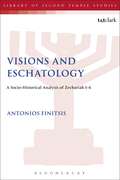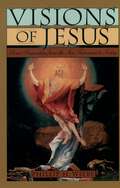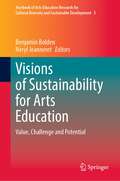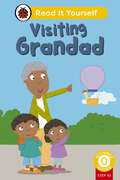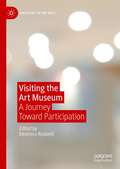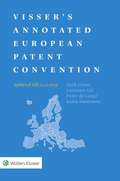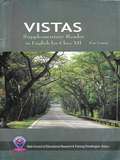- Table View
- List View
Visionary Women and Visible Children, England 1900-1920: Childhood and the Women's Movement
by Berry MayallThis book addresses the inter-linked lives and fortunes of children and women in the first two decades of the twentieth century in England. This was a time of shifts in thinking and practice about children’s and women’s status, lived lives and experiences. The book provides a detailed explanation of how children experienced home, neighbourhood and elementary school; as well as discussing the impact of the women’s movement, namely its suffrage and socialist work. These two concerns are linked by the work women did about and for children. Essentially, the book explores childhood and womanhood; generation and gender; and socialism and feminism. Using existing studies on women’s work, and autobiographies and interviews about childhood, Mayall argues that women played a large part in re-thinking childhood as a special period in life, and children as participants in learning and in politics. This book will appeal to students and researchers in the fields of history, education and sociology, particularly those interested in the women’s movement, and the history of childhood.
Visioning and Engineering the Knowledge Society - A Web Science Perspective: Second World Summit on the Knowledge Society, WSKS 2009, Chania, Crete, Greece, September 16-18, 2009. Proceedings (Lecture Notes in Computer Science #5736)
by Miltiadis D. Lytras Ernesto Damiani John M. Carroll Robert D. Tennyson David Avison Ambjö Naeve Adrian Dale Paul Lefrere Felix Tan Janice Sipior Gottfried VossenIt is a great pleasure to share with you the Springer LNCS proceedings of the Second World Summit on the Knowledge Society, WSKS 2009, organized by the Open - search Society, Ngo, http://www.open-knowledge-society.org, and held in Samaria Hotel, in the beautiful city of Chania in Crete, Greece, September 16–18, 2009. The 2nd World Summit on the Knowledge Society (WSKS 2009) was an inter- tional scientific event devoted to promoting dialogue on the main aspects of the knowledge society towards a better world for all. The multidimensional economic and social crisis of the last couple of years has brought to the fore the need to discuss in depth new policies and strategies for a human centric developmental processes in the global context. This annual summit brings together key stakeholders involved in the worldwide development of the knowledge society, from academia, industry, and government, including policy makers and active citizens, to look at the impact and prospects of - formation technology, and the knowledge-based era it is creating, on key facets of l- ing, working, learning, innovating, and collaborating in today’s hyper-complex world. The summit provides a distinct, unique forum for cross-disciplinary fertilization of research, favoring the dissemination of research on new scientific ideas relevant to - ternational research agendas such as the EU (FP7), OECD, or UNESCO. We focus on the key aspects of a new sustainable deal for a bold response to the multidimensional crisis of our times.
Visioning Multicultural Education: Past, Present, Future
by H. Prentice BaptisteOrganized by the National Association of Multicultural Education (NAME), this volume explores the organic relationship between the past, present, and future of the discipline. In particular, the book addresses the various forms of recent social upheaval, from educational inequities and growing economic divides to extreme ideological differences and immigration conflicts. Written by a group of eminent and emerging scholars, chapters draw lessons from the past two decades and celebrate present accomplishments in order to ambition a better future through multicultural education.
Visioning Multicultural Education: Past, Present, Future
by H. Prentice Baptiste Jeanette Haynes WriterOrganized by the National Association of Multicultural Education (NAME), this volume explores the organic relationship between the past, present, and future of the discipline. In particular, the book addresses the various forms of recent social upheaval, from educational inequities and growing economic divides to extreme ideological differences and immigration conflicts. Written by a group of eminent and emerging scholars, chapters draw lessons from the past two decades and celebrate present accomplishments in order to ambition a better future through multicultural education.
Visions and Concepts for Education 4.0: Proceedings of the 9th International Conference on Interactive Collaborative and Blended Learning (ICBL2020) (Advances in Intelligent Systems and Computing #1314)
by Michael E. Auer Dan CenteaThis book contains papers in the fields of Interactive, Collaborative, and Blended Learning; Technology-Supported Learning; Education 4.0; Pedagogical and Psychological Issues. With growing calls for affordable and quality education worldwide, we are currently witnessing a significant transformation in the development of post-secondary education and pedagogical practices. Higher education is undergoing innovative transformations to respond to our urgent needs. The change is hastened by the global pandemic that is currently underway. The 9th International Conference on Interactive, Collaborative, and Blended Learning: Visions and Concepts for Education 4.0 was conducted in an online format at McMaster University, Canada, from 14th to 15th October 2020, to deliberate and share the innovations and strategies. This conference’s main objectives were to discuss guidelines and new concepts for engineering education in higher education institutions, including emerging technologies in learning; to debate new conference format in worldwide pandemic and post-pandemic conditions; and to discuss new technology-based tools and resources that drive the education in non-traditional ways such as Education 4.0. Since its beginning in 2007, this conference is devoted to new learning approaches with a focus on applications and experiences in the fields of interactive, collaborative, and blended learning and related new technologies. Currently, the ICBL conferences are forums to exchange recent trends, research findings, and disseminate practical experiences in collaborative and blended learning, and engineering pedagogy. The conference bridges the gap between ‘pure’ scientific research and the everyday work of educators. Interested readership includes policymakers, academics, educators, researchers in pedagogy and learning theory, school teachers, industry-centric educators, continuing education practitioners, etc.
Visions and Eschatology: A Socio-Historical Analysis of Zechariah 1-6 (The Library of Second Temple Studies #79)
by Antonios FinitsisZechariah 1-6 is unlike most of the prophets in the Hebrew Bible. He is pro-establishment and he conveys his message mostly with visions. These observations have led to scholarly disagreements as to how one should understand his role. Antonios Finitsis mediates this disagreement by triangulating the relationship of Zechariah's visionary mode of expression, his message and his function. Zechariah has often been seen as a link between prophecy and apocalypticism. However, Finitsis argues again assuming the presence of this link - warning against the potential for reductionist thinking. Furthermore, Proto-Zechariah's viewpoint is particular to the post-exilic social setting. His visions are influenced by the social circumstances in which they are expressed. Proto-Zechariah refers to the near future using elements from the community's present. Therefore, Finitsis defines the message of Proto-Zechariah one of restoration eschatology, suggesting that the text is addressed to a small province plagued by inner-community conflicts. The text succeeds in alleviating social discord by empowering the people to rebuild their community. This presents a unique and challenging understand of Zechariah's prophetic role.
Visions for Intercultural Music Teacher Education (Landscapes: the Arts, Aesthetics, and Education #26)
by Heidi Westerlund Sidsel Karlsen Heidi ParttiThis open access book highlights the importance of visions of alternative futures in music teacher education in a time of increasing societal complexity due to increased diversity. There are policies at every level to counter prejudice, increase opportunities, reduce inequalities, stimulate change in educational systems, and prevent and counter polarization. Foregrounding the intimate connections between music, society and education, this book suggests ways that music teacher education might be an arena for the reflexive contestation of traditions, hierarchies, practices and structures. The visions for intercultural music teacher education offered in this book arise from a variety of practical projects, intercultural collaborations, and cross-national work conducted in music teacher education. The chapters open up new horizons for understanding the tension-fields and possible discomfort that music teacher educators face when becoming change agents. They highlight the importance of collaborations, resilience and perseverance when enacting visions on the program level of higher education institutions, and the need for change in re-imagining music teacher education programs.
Visions of Jesus: Direct Encounters from the New Testament to Today
by Phillip H. WiebeErnie Hollands, a career criminal, said Christ appeared to him in his cell in Millhaven Penitentiary. Maria Martinez saw Jesus at a busy intersection in Miami, Florida. Rose Fairs was lying in bed one morning when the Venetian blinds opened and the head of Jesus materialized before her. Were these people only imagining a figure that seemed life-like, or is there a chance that what they saw was, in some way, real? This first critical study of contemporary visions of Jesus offers the intriguing accounts of thirty people, most of them ordinary men and women without prior or subsequent experiences of this kind, who remain mystified about their encounters. Wiebe recounts each vision in vivid detail, exploring why these individuals believe their visions were of Jesus, and why they typically believe them to be objective happenings, rather than hallucinations or dreams. He regards the occurrences from perspectives as diverse as biblical scholarship and parapsychology, concluding that they may well represent genuine religious experiences of a mystical character. The fascinating nature of these visions and Wiebe's thoughtful, evenhanded approach to each report add up to a book that will be provocative reading for skeptics and the faithful alike.
Visions of Sustainability for Arts Education: Value, Challenge and Potential (Yearbook of Arts Education Research for Cultural Diversity and Sustainable Development #3)
by Benjamin Bolden Neryl JeanneretThis book stems from the 2019 meeting of the UNESCO UNITWIN international network for Arts Education Research for Cultural Diversity and Sustainable Development. It presents scholarly, international perspectives on issues surrounding arts education and sustainability that addresses the following questions: What value can the arts add to the education of citizens of the 21st century?; What are the challenges and ways forward to realize the potential of arts education in diverse contexts? The book discusses empirical research and exemplary practices in the arts and arts education around the world, presenting sound theoretical and methodological frames and approaches. It identifies policy implications at national, regional and global levels that cut across social, economic, environmental and cultural dimensions of sustainable development.
Visiting Grandad (Read It Yourself)
by LadybirdTwo stories that build on the phonics learned in previous steps and practise sound and letter combinations that have already been encountered.Visiting Grandad is from Beginner Reader Level 0 and is ideal for children aged from 4+ who are developing their phonics and early reading skills.Each book has been carefully checked by educational and subject consultants and includes comprehension puzzles, book band information, and tips for helping children with their reading.With five levels to take children from first phonics to fluent reading and a wide range of different stories and topics for every interest, Read It Yourself helps children build their confidence and begin reading for pleasure.
Visiting the Art Museum: A Journey Toward Participation (Sociology of the Arts)
by Eleonora RedaelliVisiting the Art Museum: A Journey Toward Participation is a book about the visitor experience. It is written as a companion for visitors to and inside the art museum. The volume engages readers in transforming a common experience, the museum visit, into a sophisticated epistemological inquiry. The study of the visitor experience through an epistemological approach consists of the untangling of the academic disciplines that study and inform each step of this experience: urban studies, architecture, design, art history, art education, and nonprofit management. This journey follows a transformative bottom-up trajectory from experiential to epistemological, and, finally, reveals itself as empowering. The book unfolds as an edited volume, with chapters by different authors who are enthusiastic scholars in each discipline and addresses undergraduate students as citizens, master’s students as professionals, and scholars as teachers and researchers. Each reader will discover a kaleidoscopic world made of ideas, values, and possibilities for participation.
Visser's Annotated European Patent Convention 2019 Edition
by Derk VisserThe book Visser’s Annotated European Patent Convention is a commentary on the European Patent Convention and a bestseller in European patent law. Each year a new, updated edition of the book is published and available in paperback form. The 2019 edition of this preeminent work – the only regularly updated authoritative article-by-article commentary in English on the European Patent Convention (EPC), its implementing regulations, and associated case law – provides the complete text of the 2000 Convention annotated with commentary and expert guidance on the interpretation of each paragraph. Since its first edition in 1994 it has provided the European patent community with the necessary insights to practice successfully before the European Patent Office. The EPO recommends the Visser’s Annotated European Patent Convention as the first book in its list of non-EPO/WIPO literature to be used for the preparation of the European qualifying examination. In addition to a thorough updating of developments, new material in this edition includes the following: New Rules of Procedure of the Boards of Appeal; New EPO Guidelines that enter into force on 01.11.2019; The references to Guidelines 2018 are kept for the eqe 2020 candidates.
Vistas Supplementary Reader (Core Course) class 12 - S.C.E.R.T Raipur - Chhattisgarh Board
by Rajya Shaikshik Anusandhan Aur Prashikshan Parishad Raipur C. G.This book prescribed by central board of secondary education, India for the students of class 12th subject English. This accessible version of the book doesn't leave any part of the book. The book is handy companion of the school going students.
Visual Alchemy: The Fine Art Of Digital Montage
by Catherine McIntyreCatherine McIntyre, like many fine artists, created traditional art for decades before encountering the versatility of digital imaging technology. Free of her Rotring pens and scalpel, she now uses Photoshop to create her montages. Visual Alchemy explores McIntyre’s sources of inspiration as well as her methods, offering an aesthetic guide to composition, color, texture and all of the other means of communication that artists have at their disposal. While these concepts and techniques make use of Photoshop, they will apply to any digital imaging program and indeed to any medium, whether traditional or digital. Featuring McIntyre’s own art as well as that of artists around the globe, Visual Alchemy is an invitation to discover the artistic possibilities of picture making through digital montage.
Visual Alchemy: The Fine Art of Digital Montage
by Catherine McIntyreCatherine McIntyre, like many fine artists, created traditional art for decades before encountering the versatility of digital imaging technology. Free of her Rotring pens and scalpel, she now uses Photoshop to create her montages. Visual Alchemy explores McIntyre’s sources of inspiration as well as her methods, offering an aesthetic guide to composition, color, texture and all of the other means of communication that artists have at their disposal. While these concepts and techniques make use of Photoshop, they will apply to any digital imaging program and indeed to any medium, whether traditional or digital. Featuring McIntyre’s own art as well as that of artists around the globe, Visual Alchemy is an invitation to discover the artistic possibilities of picture making through digital montage.
Visual and Cultural Identity Constructs of Global Youth and Young Adults: Situated, Embodied and Performed Ways of Being, Engaging and Belonging (Routledge Research in Cultural and Media Studies)
by Fiona BlaikieThis collection brings together the ideas of key global scholars focusing on the lives of youth and young adults, examining their visual and cultural identity constructs. Embracing an international perspective encompassing the Global North and Global South, chapters explore expressions and performances of youth and young adults as shifting and entangled, in and through the clothed body, gender, sexuality, race, artistic and pedagogical making practices, in spaces and places, framed by new materialism, social media, popular and material culture. The overarching emphasis of the collection is on youth and young adults’ strategies for engaging in and with the world, becoming a someone, and belonging, in settings that include a juvenile arbitration program, an artist community, high schools, universities, families and social media. This truly interdisciplinary and international collection will have resonance not just within cultural and media studies, but also in education, anthropology, sociology, gender studies, child and youth studies, visual culture, and communication studies.
Visual and Cultural Identity Constructs of Global Youth and Young Adults: Situated, Embodied and Performed Ways of Being, Engaging and Belonging (Routledge Research in Cultural and Media Studies)
by Fiona BlaikieThis collection brings together the ideas of key global scholars focusing on the lives of youth and young adults, examining their visual and cultural identity constructs. Embracing an international perspective encompassing the Global North and Global South, chapters explore expressions and performances of youth and young adults as shifting and entangled, in and through the clothed body, gender, sexuality, race, artistic and pedagogical making practices, in spaces and places, framed by new materialism, social media, popular and material culture. The overarching emphasis of the collection is on youth and young adults’ strategies for engaging in and with the world, becoming a someone, and belonging, in settings that include a juvenile arbitration program, an artist community, high schools, universities, families and social media. This truly interdisciplinary and international collection will have resonance not just within cultural and media studies, but also in education, anthropology, sociology, gender studies, child and youth studies, visual culture, and communication studies.
Visual and Performing Arts Collaborations in Higher Education: Transdisciplinary Practices (The Arts in Higher Education)
by Julia Listengarten Keri WatsonThis book examines the role of the visual and performing arts in higher education and argues for the importance of socially engaged transdisciplinary practices, not just to the college curriculum but also to building an informed and engaged citizenry. The first chapter defines and offers an outline for conducting transdisciplinary research. Chapters two through five present examples of transdisciplinary projects facilitated in Central Florida between 2017 and 2022. Topics and methodological frameworks include ecocriticism and climate change, migration, poverty, and displacement, ageing and disability, and systemic racism and mass incarceration. Each chapter includes descriptions of the projects and outlines how they integrated the essential learning outcomes articulated by the American Association of Colleges and Universities in the Liberal Education and America’s Promise report. A concluding chapter offers reflections on the value of transdisciplinary collaborative work and poses questions for further discussions on the role of the arts in higher education. The book is designed for graduate and undergraduate students, faculty, and non-academics interested in engaging in transdisciplinary projects to address complex societal issues.
Visual Approaches to Teaching Writing: Multimodal Literacy 5 - 11 (PDF)
by Eve Bearne Helen WolstencroftWhy are visual approaches to literacy important? Children's experience of texts is no longer limited to words on printed pages - their reading and writing worlds are formed in multimodal ways, combining different modes of communication, including speech or sound, still or moving images, writing and gesture.
Visual Approaches to Teaching Writing: Multimodal Literacy 5 - 11
by Helen Wolstencroft Ms Eve BearneIncludes CD-Rom Why are visual approaches to literacy important? Children's experience of texts is no longer limited to words on printed pages - their reading and writing worlds are formed in multimodal ways, combining different modes of communication, including speech or sound, still or moving images, writing and gesture. This book is a practical guide for teachers in making sense of multimodal approaches to teaching writing. The book covers topics such as: - The design of multimodal texts and the relationships between texts and images - How to build a supportive classroom environment for analysing visual and audiovisual texts, and how to teach about reading images - How to plan a teaching sequence leading to specific writing outcomes - Examples of teaching sequences for developing work on narrative, non-fiction and poetry - Formative and summative assessment of multimodal texts, providing levels for judging pupil development, and suggestions for moving pupils forward - How to write, review and carry out a whole school policy for teaching multimodal writing The book is accompanied by a CD, which contains a range of examples of children's multimodal work, along with electronic versions of the activities and photocopiable sheets from the book, and material designed for use with interactive whiteboards. It will be a valuable resource for primary teachers, literacy co-ordinators and students on initial teacher training courses. Visit the UKLA's website : here
Visual Approaches to Teaching Writing: Multimodal Literacy 5 - 11 (PDF)
by Helen Wolstencroft Ms Eve BearneIncludes CD-Rom Why are visual approaches to literacy important? Children's experience of texts is no longer limited to words on printed pages - their reading and writing worlds are formed in multimodal ways, combining different modes of communication, including speech or sound, still or moving images, writing and gesture. This book is a practical guide for teachers in making sense of multimodal approaches to teaching writing. The book covers topics such as: - The design of multimodal texts and the relationships between texts and images - How to build a supportive classroom environment for analysing visual and audiovisual texts, and how to teach about reading images - How to plan a teaching sequence leading to specific writing outcomes - Examples of teaching sequences for developing work on narrative, non-fiction and poetry - Formative and summative assessment of multimodal texts, providing levels for judging pupil development, and suggestions for moving pupils forward - How to write, review and carry out a whole school policy for teaching multimodal writing The book is accompanied by a CD, which contains a range of examples of children's multimodal work, along with electronic versions of the activities and photocopiable sheets from the book, and material designed for use with interactive whiteboards. It will be a valuable resource for primary teachers, literacy co-ordinators and students on initial teacher training courses. Visit the UKLA's website : here
Visual Art and Education in an Era of Designer Capitalism: Deconstructing the Oral Eye (Education, Psychoanalysis, and Social Transformation)
by jan jagodzinskiThis book offers a unique perspective of art and its education in designer capitalism. It will contribute to the debate as to possibilities art and design hold for the future. It also questions the broad technologization of art that is taking place.
Visual Arts with Young Children: Practices, Pedagogies, and Learning (Changing Images of Early Childhood)
by Hayon Park Christopher M. SchulteFeaturing the work of leading scholar-practitioners, Visual Arts with Young Children raises critical questions about the situated nature of the visual arts and its education in early childhood. Innovative chapters explore the relationship of place to art practice and pedagogy, culturally-responsive and justice-oriented perspectives, as well as critical and reconceptualist approaches to materials, technology and media. Ideal for researchers and students of both early childhood education and arts integration programs, this volume is an essential step towards a deeper understanding of how visual arts are understood, valued and practiced in the early years.
Visual Arts with Young Children: Practices, Pedagogies, and Learning (Changing Images of Early Childhood)
by Hayon Park Christopher M. SchulteFeaturing the work of leading scholar-practitioners, Visual Arts with Young Children raises critical questions about the situated nature of the visual arts and its education in early childhood. Innovative chapters explore the relationship of place to art practice and pedagogy, culturally-responsive and justice-oriented perspectives, as well as critical and reconceptualist approaches to materials, technology and media. Ideal for researchers and students of both early childhood education and arts integration programs, this volume is an essential step towards a deeper understanding of how visual arts are understood, valued and practiced in the early years.
Visual Culture (PDF)
by Richard Howells Rosalind GillVisual Culture is an introductory textbook book on visual literacy, exploring how meaning is both made and transmitted in an increasingly visual world. It is designed to introduce students to the analysis of all kinds of visual texts, whether drawings, paintings, photographs, films, advertisements, television programmes or new media forms. The book is illustrated with copious examples that range from medieval painting to contemporary record covers and is written in a lively and engaging style, avoiding unnecessary jargon. The first part of the book is concerned with differing theoretical approaches to visual analysis, and includes chapters on iconology, form, art history, ideology, semiotics and hermeneutics. The merits and disadvantages of each are discussed, and there is a special focus on one seminal writer for each topic. The second part shifts from a theoretical to a medium–based approach and comprises chapters on fine art, photography, film, television and new media. These investigate the complex relationship between reality and visual representation. As a whole, this textbookbrings seemingly diverse approaches together under one roof while ultimately arguing for a polysemic approach to visual analysis. Each chapter concludes with a section of recommendations for further study. Visual Culture provides an ideal introduction for students taking courses in visual culture and communication in a wide range of disciplines, including media and cultural studies, sociology, art history and design.




